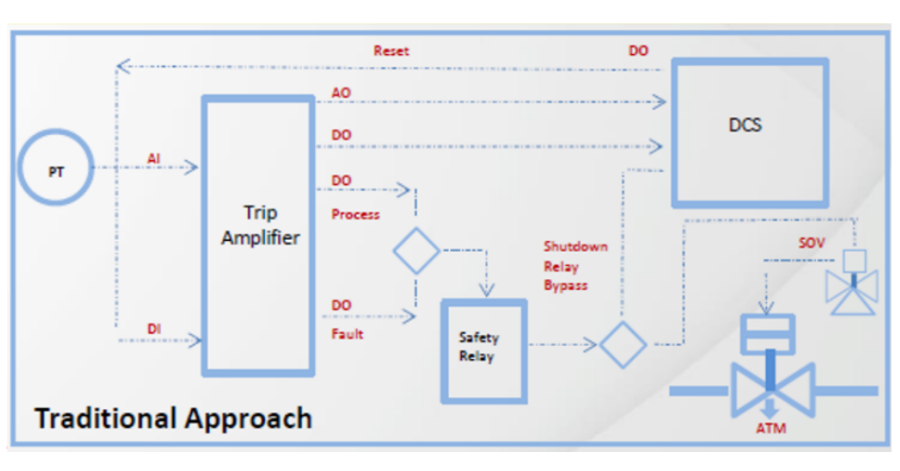A typical Safety Instrumented System (SIS) consists of a Safety Integrity Level (SIL)- certified sensor, logic solver, and final element. These SIS systems can be complex, including multiple components such as a pressure or temperature transmitter, safety relay, programmable logic controller (PLC), and trip amplifier; and requires intensive wiring and programming. See figure 1.
A newer approach using a SIL-certified safety transmitter (sensor) that includes the logic solver eliminates the complexity associated with trip amplifiers and accessory hardware. Rather than using multiple devices and a complex webbing of wiring, a stand-alone, SIL-certified transmitter with built-in relay, and trip amplifier minimizes the components, reduces maintenance, and therefore provides greater reliability while reducing cost.
See figure 2.

Figure 2
The One Series Field Safety Transmitter from United Electric Controls is different from all other SIL-certified transmitters because it functions as the sensor, logic solver, and has the relay (three-in-one) embedded into the device, allowing direct, local switching of the final element in less than 100 milliseconds. This is significant when an emergency shutdown of the final element is required at the point of measure, since the Field Safety Transmitter eliminates the lag time that could occur when using multiple components to initiate shutdown.
The Field Safety Transmitter can be installed as part of a SIS layer, or as the SIS. As part of a SIS, the Field Safety Transmitter can switch the final element directly or through a redundant safety relay status (SRS) signal through a PLC or Distributed Control System (DCS) and voting logic schemes. In remote areas and applications with limited infrastructure, the Field Safety Transmitter can act as the SIS for the final element.
Applications are far-reaching and can be used anywhere operators need to install a safety device for SIS. The three-in-one device is used within refineries, chemical plants, upstream oil and gas wellheads, water and wastewater applications, and with most pump-specific applications.
Advantages of the Three-in-One Device
Here are just a few advantages of this safety transmitter with a built-in safety relay and trip amplifier:
- It saves wiring costs because now there is only one device as opposed to wiring multiple devices.
- It saves in maintenance time because only one device requires attention, and built-in diagnostics alerts of potential faults.
- It provides confidence since it’s been tested and certified for use in SIL 2 in SIS per IEC 61508.
- Local-only programming means access to the device is manually initiated, providing a level of cybersecurity that it cannot be hacked.
- Window mode, allows an operator to control the upper level and the lower level of a process using just one device and one switch. For example, normally on a pump you would have a single contact switch protecting the pump from high-pressure damage (dead-heading), and another single contact switch protecting the pump from low-pressure damage, caused by running out of fluid and therefore running dry. However, the window mode protects against both conditions because it looks for any irregular high or low operation of the pump using the same device.
Application Example
At an upstream oil and gas wellhead site, the operating company experienced a buildup of paraffin during colder months that would block the wellhead’s hydraulic pressure measurement and shut down all four wellheads within the pad rather than just the one that was causing the problem. They installed the Field Safety Transmitter because in their remote location, the transmitter performed the only safety instrumented function (SIF) and became the SIS. In addition, the Plug Port feature allowed the operator to set a time and percent of change value for the process that would indicate a deviation from the normal operating condition. Now, if the pressure-flow were restricted on a well, the safety transmitter would shut down that well, and alert the command center, who could dispatch maintenance while the other three wells continued to operate.
Read Four Key Considerations When Selecting SIS Sensors from United Electric Controls to learn more.




